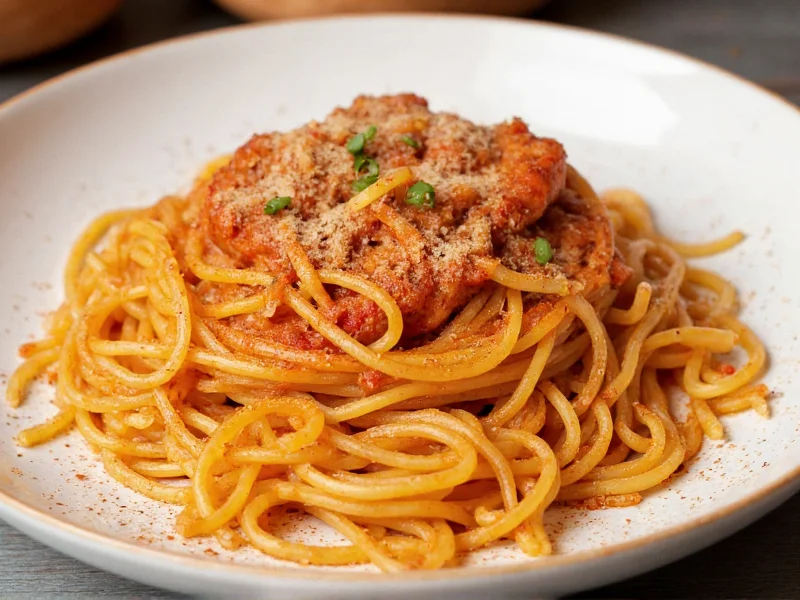Creating the perfect spaghetti dish begins with understanding your seasoning. While many home cooks reach for pre-made blends, knowing the core components allows for customization based on personal taste preferences and dietary requirements. The right seasoning blend can transform a simple pasta meal into an authentic Italian-inspired experience without requiring professional cooking skills.
Essential Components of Authentic Spaghetti Seasoning
Spaghetti seasoning differs from general Italian seasoning through its specific balance of ingredients tailored for tomato-based sauces. The foundation typically consists of:
- Basil - Provides sweet, slightly peppery notes that complement tomatoes
- Oregano - Adds earthy, robust flavor essential for authentic Italian profiles
- Garlic powder - Delivers consistent garlic flavor without burning risks of fresh garlic
- Onion powder - Contributes sweetness and depth to sauce profiles
- Black pepper - Offers subtle heat and complexity
Many commercial blends include additional ingredients like parsley for freshness, red pepper flakes for heat, or marjoram for floral notes. When selecting or creating your blend, consider whether you prefer a more traditional Italian profile or a bolder American-Italian interpretation.
Homemade vs. Store-Bought Spaghetti Seasoning
While convenient, store-bought spaghetti seasoning often contains anti-caking agents, excess salt, or inconsistent herb ratios. Creating your own blend offers several advantages:
| Factor | Homemade Blend | Store-Bought Blend |
|---|---|---|
| Customization | Complete control over ingredients and ratios | Fixed formula with no adjustment options |
| Freshness | Maximum flavor potency when made fresh | Gradual flavor degradation during storage |
| Sodium Content | Adjustable to dietary needs | Often high in added salt |
| Cost Efficiency | More economical for regular use | Convenience premium pricing |
Creating Your Perfect Homemade Spaghetti Seasoning Recipe
Producing restaurant-quality spaghetti seasoning at home requires just a few pantry staples and minimal preparation time. This basic recipe yields approximately 1/4 cup of seasoning blend:
Simple Homemade Spaghetti Seasoning
- 2 tablespoons dried basil
- 2 tablespoons dried oregano
- 1 tablespoon garlic powder
- 1 tablespoon onion powder
- 1 teaspoon black pepper
- 1 teaspoon dried parsley (optional)
- 1/2 teaspoon red pepper flakes (optional)
Preparation: Combine all ingredients in a small bowl, mixing thoroughly to ensure even distribution. Transfer to an airtight container for storage. For enhanced flavor development, let the mixture sit for 24 hours before use to allow the flavors to meld.
This versatile homemade spaghetti seasoning recipe can be easily modified based on personal preferences. Reduce the red pepper flakes for milder flavor or increase the garlic powder for more pronounced savory notes. The beauty of creating your own blend lies in the ability to adjust proportions until you achieve your ideal flavor profile.
Optimal Usage Techniques for Maximum Flavor Impact
Understanding how to use spaghetti seasoning properly significantly impacts your final dish quality. Professional chefs recommend:
- Bloom the spices - Add seasoning to hot oil or sauce base for 1-2 minutes before incorporating other ingredients to release essential oils
- Layer flavors - Add half the seasoning early in cooking and the remainder near the end for complex flavor development
- Adjust for acidity - Increase oregano slightly when using highly acidic tomatoes to balance flavor profiles
- Taste and adjust - Always taste sauce 10 minutes before completion to fine-tune seasoning levels
When working with spaghetti seasoning vs Italian seasoning, remember that spaghetti-specific blends typically contain higher garlic and onion concentrations. If substituting Italian seasoning, consider adding extra garlic powder to maintain authentic spaghetti sauce flavor.
Proper Storage for Long-Lasting Freshness
To maintain optimal flavor in your homemade blend, follow these storage tips for homemade spaghetti seasoning:
- Store in airtight glass or metal containers (avoid plastic which can absorb flavors)
- Keep in a cool, dark place away from heat sources and direct sunlight
- Label containers with creation date for freshness tracking
- Use within 6 months for peak flavor (though safe indefinitely if stored properly)
For extended shelf life, consider storing larger batches in the freezer. Freezing preserves volatile oils in dried herbs, maintaining flavor potency significantly longer than room temperature storage.
Effective Substitution Options When Spaghetti Seasoning Is Unavailable
Running out of spaghetti seasoning doesn't mean compromising your meal. Consider these spaghetti seasoning substitution options based on available ingredients:
- Basic Italian seasoning plus garlic - Use 1 tablespoon Italian seasoning plus 1 teaspoon garlic powder per serving
- Tomato sauce enhancer - Combine equal parts dried basil, oregano, and garlic powder
- From-scratch alternative - Mix 1/2 teaspoon each of dried basil, oregano, garlic powder, and onion powder
- Fresh herb option - Substitute with 1 tablespoon each fresh basil and parsley, plus 2 minced garlic cloves (add later in cooking)
When substituting, remember that fresh herbs generally require triple the quantity of dried herbs, but should be added later in the cooking process to preserve their delicate flavors.
Perfect Pairings: Maximizing Your Spaghetti Seasoning Potential
While obviously essential for spaghetti dishes, your authentic spaghetti seasoning blend has versatile applications beyond traditional pasta:
- Meat preparation - Rub on chicken, pork, or beef before roasting
- Soup enhancement - Add to minestrone or tomato soup for depth
- Vegetable seasoning - Toss with roasted vegetables before cooking
- Bread dipping oil - Mix with olive oil for authentic Italian bread dipping
- Sauce base - Incorporate into pizza sauce or marinara for consistent flavor
For easy spaghetti seasoning mix integration into various dishes, start with smaller quantities and adjust to taste, as different applications require varying intensity levels.











 浙公网安备
33010002000092号
浙公网安备
33010002000092号 浙B2-20120091-4
浙B2-20120091-4